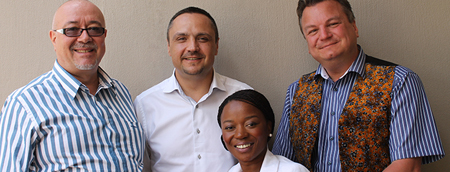SA-YSSP scholars attend high level colloquium with policy makers and research stakeholders
|

|
From the left are: Prof Frans Swanepoel, Deputy-Director of the African Doctoral Academy, Drs Aldo Stroebel, Executive Director: International Relations and Cooperation at the National Research Foundation, Priscilla Mensah, co-director of the SA-YSSP, and Ulf Dieckmann from the International Institute for Applied Systems Analysis and Dean of the SA-YSSP.
Photo: Renè-Jean van den Berg |
Scholars taking part in the 2nd Southern African Young Scientists Summer Programme (SA-YSSP), attended a one-week seminar hosted by the African Doctoral Academy at the Stellenbosch University, which concluded with a colloquium at the Stellenbosch Institute for Advanced Study.
This was part of the final leg of their three-month stay and studies at the University of the Free State.
This seminar was a capacity development intervention with the purpose of equipping SA-YSSP young scholars with the skills to communicate their research work effectively with different audiences.
The 36 scholars were hand-picked from some of the world’s most promising and top researchers to take part in the novel three-month programme for advanced doctoral candidates. Their research interests closely aligned with the Department of Science and Technology’s (DST) grand challenges and the International Institute for Applied Systems Analysis’ (IIASA) current research programmes regarding global environmental, economic and social change.
The SA-YSSP is an initiative that contributes to the establishment, growth and enhancement of high-level strategic networks internationally. At the same time it develops capacity in systems analysis at the PhD and supervisory levels through research conducted in the areas of the Department of Science and Technology’s (DST) grand challenges.
At the colloquium, students were expected to showcase their work and research according to their various fields of expertise. High-profile policy makers and policy funders, as well as academia and fellow researchers judged and critiqued the work.
Dr Priscilla Mensah from the UFS and co-director of the programme, says it is important for the young scientists to frame their findings in a way that will be relevant to policy makers and the public at large.
“The partnership with the African Doctoral Academy was crucial in this regard since it is a capacity development entity aimed at strengthening and advancing doctoral education, training and scholarship on the African continent. The objective of this week-long capacity strengthening intervention is to equip the young scientists to be able to communicate their research effectively with different audiences, including potential funders and policy makers.
“I am convinced that the young scientists will no longer view policy makers as abstract entities, but as stakeholders who must be engaged to facilitate implementation of evidence-based policy.”
Dr Aldo Stroebel, Executive Director: International Relations and Cooperation, National Research Foundation, says the purpose of the colloquium is to bring together different sectors in one room to look at different challenges holistically, with an emphasis on systems analysis for a common goal.
The SA-YSSP forms part of an annual three-month education, academic training and research capacity-building programme jointly organised by IIASA, based in Austria, the National Research Foundation (NRF) and the DST. IIASA is an international research organisation that conducts policy-oriented scientific research in the three global problem areas of energy and climate change, food and water, and poverty and equity. South Africa’s engagements with IIASA, specifically with regard to the SA-YSSP, relate primarily to the DST’s Ten-Year Innovation Plan.
The UFS is the first institution outside Austria to host the summer programme. Researchers in the programme are, among others, from South Africa and the rest of the African continent, the USA, the Netherlands, India, Hungary, Austria and Germany.